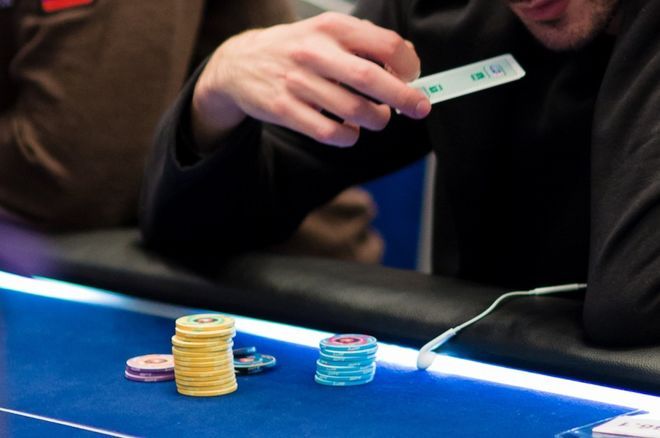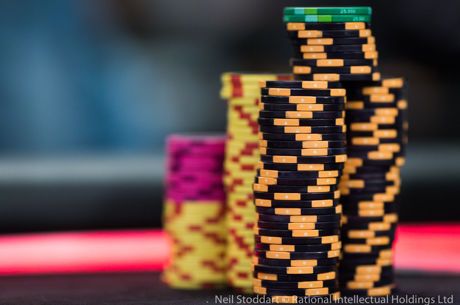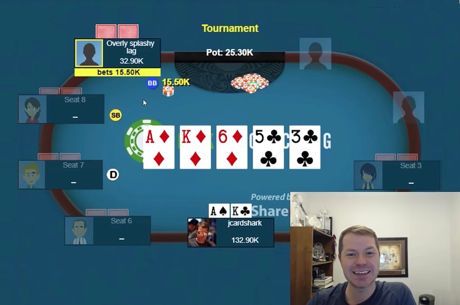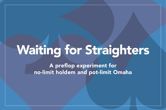His and Hers Poker: The Power of Folding

Hello, Poker Friends! This week's article presents folding in a way you've probably never thought of it before — as an offensive weapon in your poker arsenal.
The Table and Villain(s)
Hero (Tracey) is at a $2/$5 table at the Borgata. It is a very interesting weekend. There is a tournament populated by players who won their entries from playing at satellites in local bars. These "bar league" folks are, on the whole, below-average players who are highly loose and passive. Many have drifted over to the cash tables after being knocked out of the tourney.
The Main Villain for this hand is on the button. He may be a bar leaguer, as Hero has never played with him before. He is around 25 years old and wears a hoodie. His play has generally been loose and passive, but in one prior hand he showed a flash of aggression by shoving all in on the turn with a good combo draw.
Stack Sizes: ~$1,000 (Villain); ~$900 (Hero); Others have $500-$1,000.
Preflop
Action
The player under the gun limps. The next player opens to $20. It folds to the player in the hijack seat who calls. The Villain calls from the button. The small blind folds. Hero is in the big blind with Q♠J♠ and calls. The limper from under the gun calls, and we go five-way to the flop.
Analysis
Whenever we have a hand which we want to play from the blinds, we should at least give a thought to the possibility of squeezing. By definition, a squeeze is a three-bet after there has been an open and a subsequent call.
A squeeze is so named because it leverages the disadvantages facing each player in order to generate fold pressure. The opener has to worry that, if he calls, he could wind up playing out of position to the players behind him. The players behind the opener have the disadvantage of playing the hand with a capped range since they did not three-bet the opener themselves.
A highly playable hand like Q♠J♠ is a good one with which to squeeze, as it can flop well on many textures if the three-bet does not take down the hand preflop. However, a call is probably preferable to a squeeze in this particular hand. The trouble with squeezing in this spot is the sheer number of other players left to act. Particularly at tables filled with loose players, a single call tends to be the first domino in a series of subsequent calls from all players behind.
Let's look at the consequences of that happening here. If we three-bet to $120 and get (on average) two other players to call us, that will give us a pot of around $380 on the flop. With $780 left in Hero's stack, that gives us a stack-to-pot ratio of around 2-to-1. Low SPR's like that are suited to hands which are going to be comfortable stacking off on the flop with one pair, as that is when we will reach the point of pot commitment. Q♠J♠ is simply not a hand that falls into that category and, therefore, should not attempt a squeeze in this particular spot.
Flop
Action
With $102 in the pot, the flop comes J♣7♥9♠. Hero, the UTG player, and the original preflop opener all check. The hijack bets $35. The Villain calls from the button, Hero calls from the big blind, and the other two players fold.
Analysis
While we should be defending here with top pair, we need to realize that this spot is actually fairly close. With this many players in the hand, it is unlikely the bettor and caller both have particularly weak hands. There are also fewer draws which our opponents will be continuing with since the board is a rainbow.
If we had AxJx, we could proceed with greater confidence. However, with a queen-kicker, we need to be prepared to think hard about continuing to defend if we are faced with major action on the turn.
Turn
Action
With three players still in the hand and $205 in the pot, the turn is the J♥, for a turn board of J♣7♥9♠J♥. Hero checks, and the player in the hijack (who bet the flop) also checks. The Villain checks as well.
Analysis
After we hit trips and the turn checks through, we should be prepared to bet the river for value, figuring that neither player would miss the opportunity to bet the turn with their own trips (or better).
River
Action
The pot still contains $205 when the river brings the 6♥ for a final board of J♣7♥9♠J♥6♥. Hero bets $100. The hijack folds. Villain raises to $300. Hero calls. Villain tables 7♣7♦ and wins with a full house.
Analysis
Following the plan, Hero bets with her trips. Hero may have wanted to consider going even smaller than $100, as she is value targeting something in the realm of 10x10x or A♣9♣. Those holdings will need to be highly incentivized to call on a paired board with a completed flush draw.
When some players raise this river, there would be only two possibilities: (1) it is a bluff, or (2) they hit the flush. There are very few combos of both pure bluffs and flushes which called the flop, so we would likely struggle to decide how to proceed.
Against this Villain, however, there is a third possibility: (3) he hit a boat (or better trips than ours) on the turn and slow played it. Option No. 3 is always a real possibility when we are dealing with a below-average player who has not yet learned that poker is about money, not deception (see our prior article on this topic). With this additional option in play, we are up against a stronger overall range on the part of Villain.
Tracey said that she called here because she had seen Villain act with some aggression in a prior hand by raising with a draw. Therefore, she felt that he might be capable of bluffing.
We see here the danger of lumping all instances of an opponent's aggression together. When you play online, the action is so fast that you have to rely on things like an aggregated "aggression score" on your HUD. In live play, you have the benefit of time to catalog more carefully your opponent's tendencies.
Villain shoved the turn in a prior hand with a good combo draw. That is miles away from putting in a bluff-raise on this river. When Hero bets the river, her line is entirely consistent with having a flush or trips. How much of the low stakes population do you think is going to attempt a bluff-raise in that spot? Almost none.
Here is the main lesson of this hand. When discussing this hand with Matt, Tracey said that she felt that if she didn't defend here with trips, then she was grossly underdefending.
Presuming that she would raise the flop with two pair or better, if she folds her trips here on the river, then she would only be defending this raise with a miniscule number of flushes. And, that's exactly right! Good poker is all about punishing imbalances in your opponents' play. When players at your level are grossly underbluffing in a certain situation, grossly overfolding is the proper strategic response.
The Takeaway
If you make an awesome hero call, you probably feel great about yourself. Do your best to look at your hero folds in the same way. That can be hard, since the chips are not getting pushed in your direction. However, in poker, a chip saved is truly a chip earned. Folding is a weapon, so use it!
His and Hers Poker is a free, weekly strategy podcast hosted by Matt and Tracey Waldt. They are a married couple who play live cash games on the East Coast. Their podcast focuses on providing practical advice about hand reading, with an emphasis on how to identify and exploit the common leaks and imbalances of low-stakes players. His and Hers Poker can be found on iTunes, Google Play and other podcast services. For more information, and to subscribe, please visit hisandherspoker.com.









